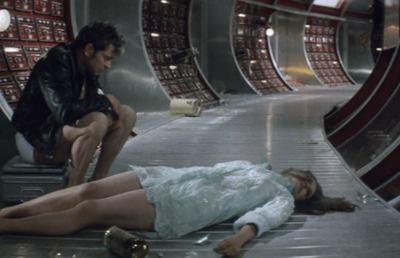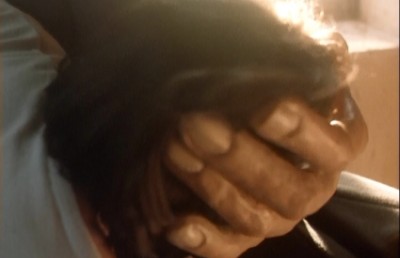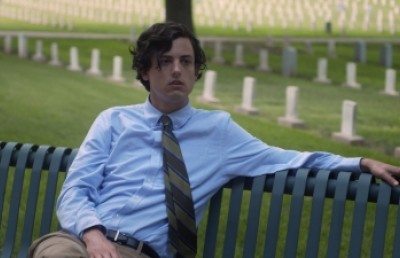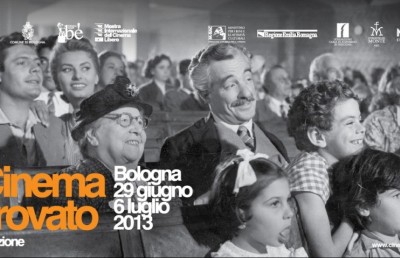Three Films by Sokurov and Their Literary Progenitors
Cinema Guild Box Set
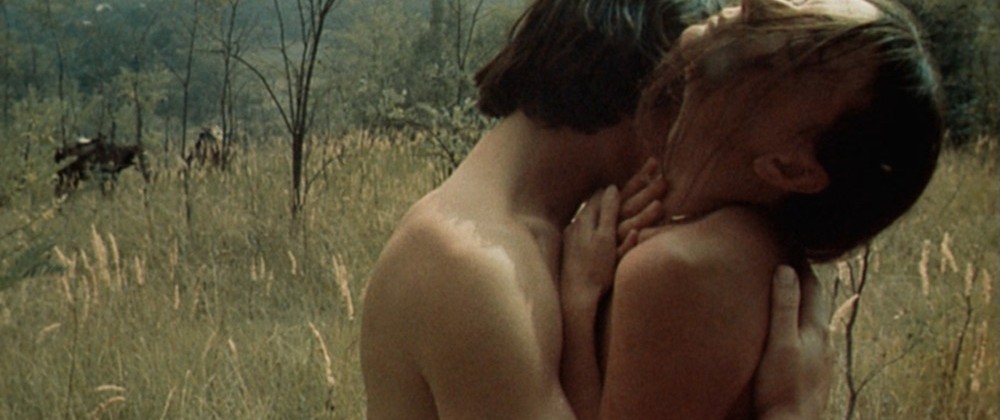
The great Russian filmmaker Alexander Sokurov has made a vast array of different kinds of films over his career but it is fair to say that he has consistently drawn inspiration, direct or otherwise, from works of literature as well as those of other arts. The new Cinema Guild DVD/Blu-Ray box set includes three such films and allows us access into Sokurov’s unique style of literary adaptation, one which might more accurately be labelled an interaction.
Save and Protect
1990’s Save and Protect is based on Flaubert’s Madame Bovary but right away a variety of challenges are posed to us. Sokurov’s film assumes a knowledge of the source material as it casts us immediately into events from the text with little to no establishing set up. There is also the way in which this very European material is appropriated. The Russian inflection may not be prominent but it is clear and the effect of Sokurov’s own thematic preoccupations is pronounced and has an impact as well. Furthermore, he uses the source material as a kind of foundational space for reflection upon specific ideas and here we start to see a specific strategy emerge which he will return to and develop.
There are echoes of other films. Like Days of Eclipse, this is an exile narrative, one in which the spiritual exile is just as emphasized as the physical. Critically too (and particular to Sokurov) there is an awareness of just how analogous to death that exile is. Like Second Circle, Save and Protect is very much concerned with death, mired in it even. And that’s because we are essentially observing the feature length prolonged death of the protagonist; even before her enforced physical demise her spirit is clearly suffocating for lack of an ability to be released from its stifling confines. So the emphasis is different from Second Circle but the concentration of focus remains very much the same and acts as testament to the seriousness with which Sokurov clearly takes his subject. In this case the metaphorical death of spirit is equivalent to that of the physical body. And a similar question arises in both films: what is our responsibility to that understanding?
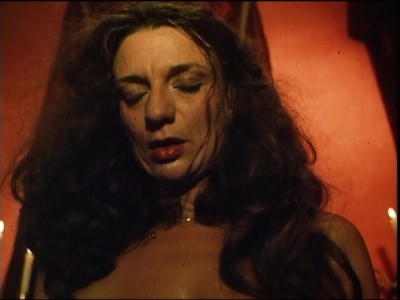
Cécile Zervudacki as Emma in rapturous sex-as-death in Save and Protect
Certainly the desperate desire for release is the driving force behind both Sokurov’s plot and the main character herself. It is her main characteristic. This then is to be distinguished from a more porous Flaubert Bovary figure who suffers for a variety of reasons but for whom that suffering is in some sense ironically qualified, or at the very least mediated, through her constant appeal to a romantic ideology. By contrast Sokurov’s Bovary is transparently desperate but less in thrall to the romantic ideal. For her the sweep of romantic passion constitutes a fitting analogue for the escape she seeks. It is less about capturing a specifically determined state and much more about the events as effects, representational states. It is not inappropriate to note that the overtly symbolic birdcage she keeps on her open window sill contains birds she keeps caged herself.
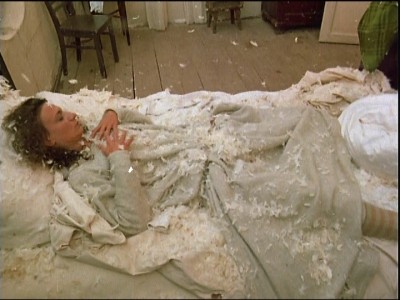
Save and Protect
The feathers that cover her bed in the beginning are alternately from her pillow and yet still ably make the link, externalizing an internal psychic state, resulting in an expressionist rendering. Her erotic encounters, meanwhile, seem like portraits of and outlets for that desperation inevitably accompanying degradation. She is rarely elated. It is mostly a disappointment we see; a desperation born of relentless disappointment. She does after all admonish her lover to listen to “the voice of nature.” She is saying that there is very little love in the world and if we stop loving each other, she will die. The world will turn to ruin.
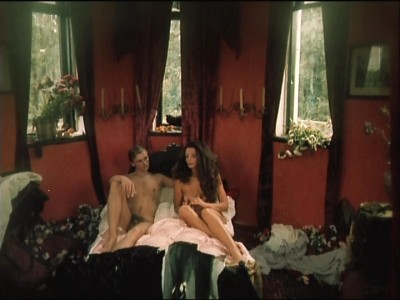
Save and Protect
It is a profound portrait of a non-integrated world and yet one that is nonetheless whole and oppressive. Bovary plays coquette with a fan on several occasions early on but this inclination is undercut or at least complicated and problematized. For immediately after one of these occasions we see an extended bluntly depicted sex scene between she and her oafish doctor husband. Bestial grunting is pronounced and prominent; it’s clearly “base” and presented to us that way directly yet the classical score continues over it, implying that this is a whole world, impossible to escape and yet just as impossibly breached, fissured in severance of its component elements. The score carries over to a scene set around a kitchen table besieged by flies. And elsewhere protracted depictions of earthy sensuousness overwhelm this Bovary whose struggle toward flight is what provides a direct line to all the cosmological and operatic aspects. She connects earth to sky.
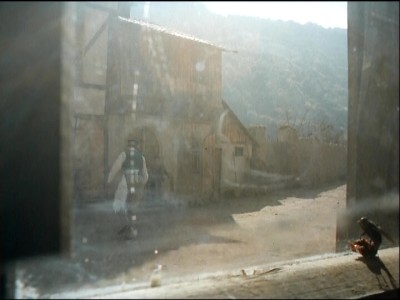
Save and Protect
Here the immediacy of Sokurov’s scenario is paralleled by the immediacy of the themes—in this case gradations of the earthy, brutal and blunt. This Bovary can do nothing else but retreat into an opposing dream of elegance in the face of such an oppressive imbalance. When she visits the money lender, for instance, her elevated desires are set against the blunt livestock in foreground obscuring her. Yet still the inherent schism Sokurov documents has very real effects on ideals. His Bovary is not a classic beauty of ideal perfection and he emphasizes that through an aesthetic of consistently distorted angles. Similarly the surrounding locale is hardly a verdant one and that too is emphasized through camera and dialogue. Save and Protect lacks the dramatic, classical value and satisfying clarity of the Chabrol version of Bovary for instance or the narrative precision of the Minnelli and it’s certainly infinitely less elaborate in detail than Oliveira’s Vale Abraão.
Again, Sokurov’s intent would seem to be that we see the coming together of Bovary’s desperation into Romantic expression. Even her consumption of arsenic is staged like a desperate dramatic act of theater. Feathers are in the air once more during her deathbed scene, which is also shot through with a desperate need for physical intimacy. Imminent death and the prospect of brutish negation compels an acting out. Contrast the subsequent funeral procession’s silent sobriety to all this earlier hysteria. Yet the absurdity of coffin burial specifics makes stately procession an inevitability simply to accommodate a grand oversized view of self (imposed by her impressionable husband) and provides a kind of spectacle in death with an accompanying and already assumed de facto social stature secured. Sokurov is not unsympathetic to his Bovary but regards her narrow desires, however floridly expressed, as an ultimately robust but impoverished Romanticism.
Stone
Sokurov’s 1992 film Stone is a far more rigorously refined work than Save and Protect. But at the same time it is also, via its extreme and rarified form, even more ambiguous. In fact, that aspect becomes the prominent characteristic. The basic premise here is just about all the “story” there is and even that could scarcely be more vaguely defined. We are led to understand that the events of the film take place at what would appear to be a museum or preserved home. And, further, we may come to understand the famous inhabitant of this home as the writer Chekhov and the phantom visitor to be the man himself resurrected. But no partial description of this sort can possibly do justice to the unique strangeness of the entire enterprise nor to the extremely indirect way in which material is presented to us. We may come to understand all of the above and then again we very well may not. Here, once again, we see Sokurov’s penchant for relying on his audience to bring an already existing knowledge into the experience of viewing his film. The question does then shift to why Sokurov would choose this technique, this uniquely vague manner of presentation. One possibility may be observed in the way in which the singular de-emphasis of character and plot based specifics serves to redirect that emphasis elsewhere, in this case to the elemental world itself, a corollary of the earthy immediacy we witness in Save and Protect. And that is fitting as this is ultimately a narrative concerned with, even obsessed by, the idea of fundamental material things, the so often overlooked world that surrounds and engulfs us, that we are all in fact a part of. We see it first in the introduction of the Chekhov character, ritualistically bathing in a supplication pose in a kind of de facto baptism—in this case of the spirit made manifest as man, as material. The implication throughout is of a not so subtly implied desperation for material existence again, for all the tactile sensations of which pure ephemeral spirit is summarily deprived (the reverse flight to that of Bovary). And the irony is that this takes place within a museum setting which Sokurov goes to great pains to realize for us as a dead space, a place of life frozen or captured forever as it once was at one moment in time. It’s a preservation in amber that denies all possibility of the reigniting of life, if not outright effectively blocks it.
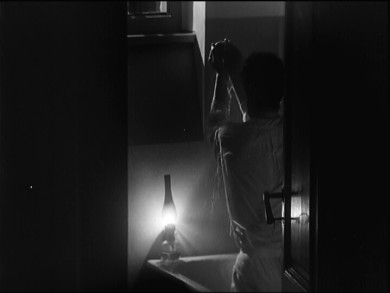
Stone
The revelation and presentation of an antique piano upon which Chekhov plays a few notes is an example. The tones of the music, however tentative or partial, break the silence and act as an assertion of presence but this is not accomplished easily. Even evoking simple tones is depicted as requiring great effort, almost superhuman effort, and in doing so Sokurov aligns fundamental physicality with a metaphysical reality, one in which the emergence of material distinction merits its significance.
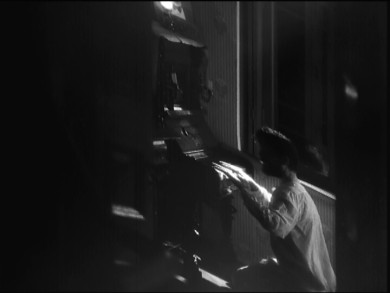
Stone
The sterility of the museum setting also offers up additional resonance. It is a relentlessly cold dreamscape environment, an unreality that aesthetically recalls the most primitive imaginable silent film work. In doing so Sokurov makes the circumstances that much more degraded, inaccessible. As such, Stone acts as the opposite stylistically and thematically to Sokurov’s own great Russian Ark, a celebration of history as culture, understood through the valued efforts at museum preservation. Stone is closer in kind to Oliveira’s 1992 film Day of Despair, which chronicled in similar funereal tone the final days of the Portuguese novelist Camilo Branco as depicted through dedramatized re-enactments shot on location at his historic home, now a nationally preserved site. The difference though is that Oliveira’s film, as is characteristic of that director, emphasizes a stripped down theatricality to the presentation, one which seems an appropriate corollary for its subject as a man of letters and language. It is a more mysterious move, perhaps, that Sokurov would choose such an extreme aestheticized style for his treatment of a similar figure. It may be that here we get a clear indication of his attitude toward cinema as a translator of other art forms. He privileges cinematic form rather than some symbiosis or attempt at integrating artistic disciplines or languages. Whether he believes such an effort is possible or even advisable is secondary to the very real fact of his subsuming of the Chekhov figure into a purely cinematic texture. What we may know of Chekhov will benefit us as it will serve to infuse the scenario with that much more additional meaning but otherwise Sokurov seeks to subordinate individual personality to the substance of a cinematically rendered cosmology. To what degree the particulars of that cosmology may sync or not with Chekhov’s recorded perspective would require a engagement with the original texts which undoubtedly Sokurov would encourage.
There is also the character of the disaffected watchman. He is, in fact, the only other character of any note and, just as with the Chekhov figure, his actual persona and occupation are only vaguely defined; he could be the effectively blanked out representative for any number of the worn down and alienated. Key to the presentation is this understated contrast. Neither the watchman nor Chekhov expresses a great deal of enthusiasm about anything (they are both, in fact, remarkably stoic) and yet over the course of the film’s brief running time we come to discern distinctive shifts in their attitudes. For the watchman, who is otherwise unaffected, it is the presence of an anomalous bird that manages to bring out, if not enthusiasm, than at least a genuine kind of curiosity, the vitality of engagement. Chekhov, meanwhile, when asked about the other state from which he has re-emerged says simply, “There is nothing, nobody there.” He is morose at this reality he must return to and yet for that very reason pensively grateful for the tactile compensations of this state. His engagement with it then is not overtly enthusiastic but rueful, bittersweet and finally reverent. This contrasts to the watchman for whom material reality holds no allure and appears as nothing but a continuous disappointment. He even indicates his interest in returning with Chekhov to the state of comparative non-being or death (“I’ll go with you.”) and this after he has been told directly that what awaits him is negation and void. Chekhov finally responds to his muttered wish by saying, “I think you have not understood this life.”
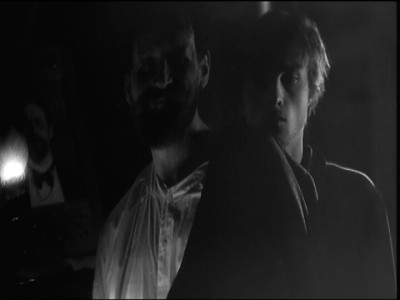
Stone
There is a great gravity and tenuous fragility to this effort to reclaim sentience and renew tactile senses. The risk is to be overwhelmed by the simplest sensation –hence the swelling orchestral fanfare to accentuate that during the extended sequence of Chekhov dressing for dinner. It seems significant that these are not simply any clothes but the reconstruction of a cultural identity, the return of a frozen past enlivened, given new life with that swelling score. His reconstitution immediately gets absorbed into the museum’s whole purposive being; this is what “comes alive” here and there is thus a certain ironic melancholy to that, a further inescapable sense of determined destiny.
The sharing of the meal becomes a major event, reestablishing or reaffirming here again an innate significance and a meaning to a distinctive act. Finally, at the end of the film, there is a different kind of re-emergence, this one along the same corporeal plane as these figures leave the frozen history of the museum and venture outside. Here they observe the living town below, stilled into its own silence by the lateness of the hour. And as he has throughout, Chekhov remarks on the cold, reminding us he maintains a tense relationship with that other realm and an equally fragile hold on this one.
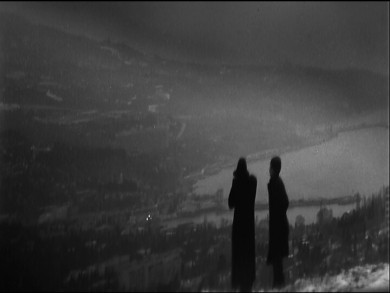
Stone
Whispering Pages
1994’s Whispering Pages states upfront that it is “based on works of Russian writers of the 19th century” yet the prominence of the language is reduced again here. And the reassurance of a clearly defined space and time is denied to us as well. Sokurov’s signature distorted or contorted images contribute to dislocation but also to the despairing feel of the whole film as though something fundamental has been irrevocably warped through sheer consistency of applied technique, here made more so by color desaturation too.
The aesthetic is flattened and drained, made morose. The soundtrack is most often muted sounds, always remote and far away, with an emphasis on inaccessibility once again. As with the previous films discussed here, it helps to already know the source material as so much of the plot occurs almost as an aside, incidental or ancillary to the pervasive mood. The narrative events then exist as a component and emanation of that mood not a cause for it. The societal tone is established in texture as the foundational metaphysical property, the fundamental derivation of all else.
The primary struggle within this material is the issue of to what degree a moral decision matters. Though the film draws on the established atmosphere and worldview perspective of “Russian writers of the 19th century” it is Dostoevsky’s Crime and Punishment, with its unique emphasis on moral questioning, which emerges as the most directly influential model. The environment through which the unnamed central figure wanders is a chaos of anarchic streets and drifting, aimless hordes, all further encumbered by an enveloping and dour atmosphere of pervasive, palpable despair. This central figure, the film’s Raskolnikov representative, passes through theatrical spectacle within a city with almost no access to the sky above; it’s an enclosed and hermetic environment, a societal hothouse granting an observance into the effects of a generally accepted set of values or the lack thereof. There is no release from the strictures of this world and, as with the intimated confinements in Save and Protect, it is an extremely earthy one which here too is distinguished by a defiant lack of additional dimensions. It is internally fractured but still unified externally; all is organic to this nature.
There are writhing huddled masses of people grappling on the floor of what seems a pub, extending out into the catacombs of the city proper and a long sequence of people leaping over barricades into an open pit. This is strangely made hellish because of its relentless quality, the state of free falling itself made the point by virtue of the exclusion of the point of impact. Only an image of a city reflected in water exists to suggest perhaps some possible purpose or idyllic alternative, though this too is made unstable and uncertain by the composition of the water itself. It becomes a wavering mirage but remains an ideal nonetheless. The illusion is its attainment. Bursts of inexplicable violence occur although ultimately they are as explicable as anything else in an obtuse or oblique world within which the structuring principles may as well be random chaos for how comprehensible they are. Snatches of angelic female vocals are barely heard through a mesh of virtually indistinguishable street sounds, almost all equally off screen and remote. The female voices do, however, act as precursor or harbinger to the appearance of “Sonia”; they echo a similar disruptive quality of grace amid the chaos and ruckus. Distinguishable color also enters with her appearance.
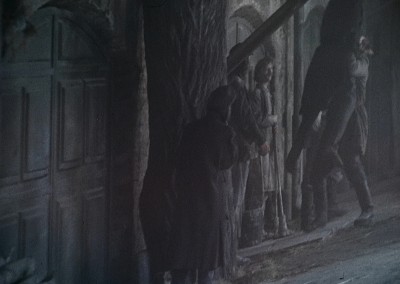
Whispering Pages
Beyond the issue of morality there is the corresponding issue once more of death and its treatment. We are reminded of the end of Save and Protect but also of the many other appearances of this theme in Sokurov’s work, most notably The Second Circle and Mother and Son. Without question he sees this as an issue of grave seriousness and inextricable from an inquiry into moral attitudes, indeed evidence of those attitudes. The final extended dialogue clarifies the direct association with the literary source as did the ending of Save and Protect but this material is more perfectly aligned with his sensibility and evident interests. The film ends on a note of real resigned despair but also in that a kind of coming-to-terms rather than outright defeatism. There is a sense in which the recognition and acknowledgment of this universal state of damnation is finally purgative, cleansing, even valuable in its necessity.
Whispering Pages recalls the same silent film techniques Sokurov evoked in Stone but also something even more fundamental and elemental in the history of art. Frozen images like illustrations dissolve like pages being turned so that the film acquires nothing less than the status of an illuminated text with a subject matter as holy and sacred as any other. Mist rolls up over these still images continually from outside, from the underworld cauldron of the infernal city, fortifying an obscure connection which suggests at times that these may be products of this place and the inhabitants within. There are many disassociated images throughout the film with little clear continuity or connection between them, consequently an enveloping disharmony is emphasized. But these frozen dream images complicate that by evidencing a latent and wistful sense of remove via artifice dreaming of artifice. This could be the only vestige of hope for an expanded vision of reality but it could also be Sokurov’s cultural critique secured into place, the final assessment of a society whose only longing is for escape and not constructive, creative engagement.
Cinema Guild’s deluxe box set of these three features also offers a robust supply of valuable extras for further perusal and enlightenment. There are three documentaries by Sokurov as well as one about him along with a short film, BBC audio presentation and a feature length commentary by James Quandt on Stone. This is truly a bevy of riches that extend our understanding of the man and his art. But the real treat is just to have such lavishly presented and attentively rendered versions of the films themselves (with Whispering Pages in a sterling Blu-ray edition). The slip cased set fits appropriately on a shelf next to the very volumes that inspired it and to which it exists as complementary resource.



